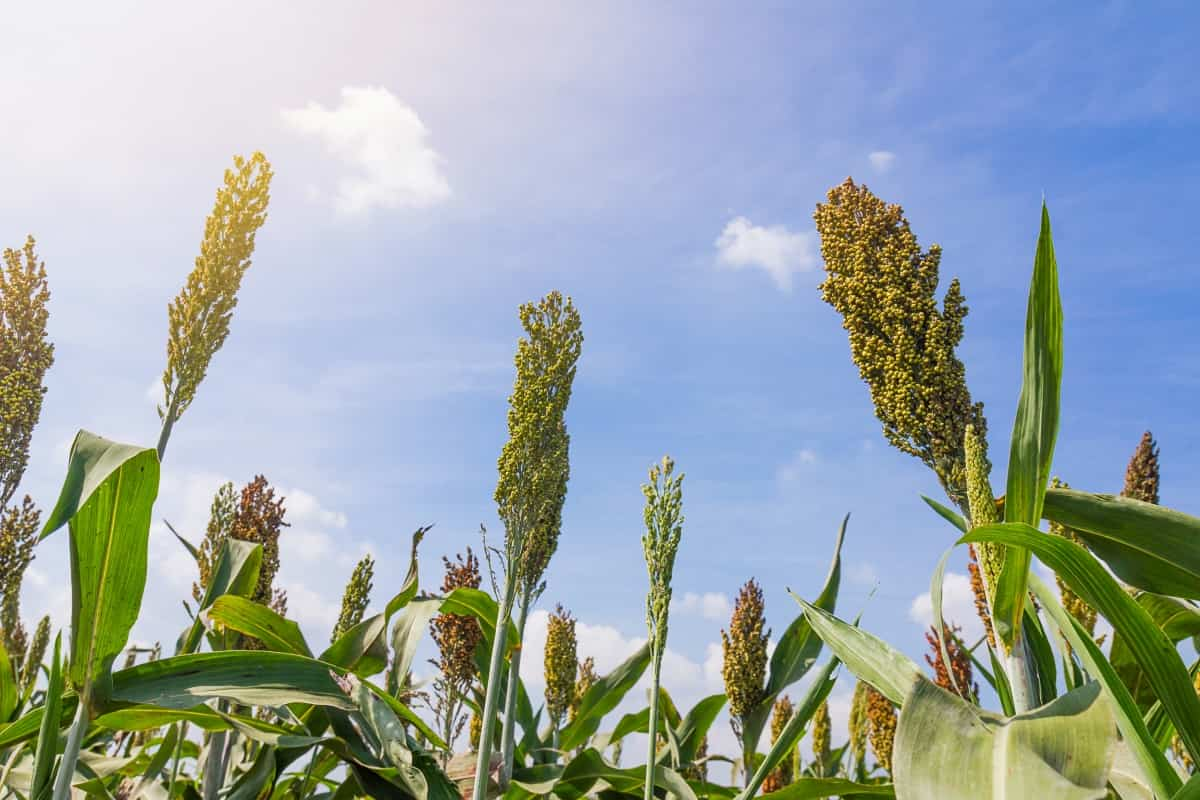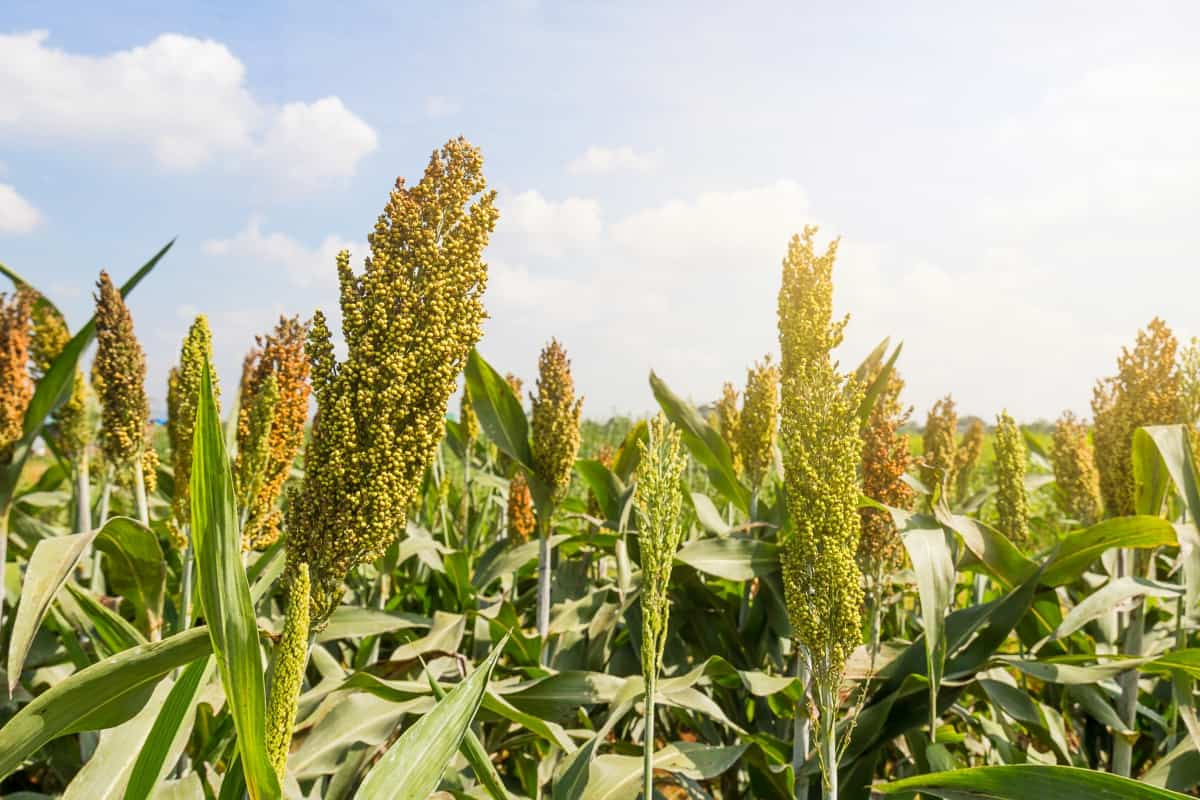Sorghum, a versatile and drought-resistant crop, is a staple in the agricultural industry in Nebraska. This cereal grain has become the fifth most important cereal crop globally. Here we learn about the journey of sorghum from seed to harvest in Nebraska, including the process of land preparation, planting, fertilization, and harvesting, as well as the climate’s impact on this resilient crop.

Grow Sorghum in Nebraska
Land Preparation for Sorghum Farming
The first step in growing sorghum is preparing the land. Farmers in Nebraska typically prepare their fields in the fall after completing the harvest of other crops. This process involves clearing any remaining crop residue and tilling the soil to create a smooth, level surface that promotes good seed-to-soil contact. Depending on the field’s condition, farmers may opt for conservation tillage methods to reduce erosion, conserve soil moisture, and promote soil health. Proper land preparation is crucial to ensure optimal sorghum crop germination, growth, and yield.
Climate and Growing Season
Nebraska’s climate is ideally suited for sorghum farming. The state experiences a continental climate with hot summers and cold winters, offering a suitable environment for sorghum growth. Sorghum is a warm-season crop, requiring temperatures between 60-90°F (15-32°C) for optimal growth. The average growing season for sorghum in Nebraska is around 110-120 days, depending on the variety and local climate conditions.
Planting Sorghum Seeds
Planting sorghum seeds in Nebraska typically occurs in late April to early May, as soil temperatures reach 60°F (15°C) or higher. Farmers select sorghum varieties based on their maturity period, disease resistance, and desired end-use. Seed selection is crucial, as it directly impacts the crop’s yield and quality.
The planting depth for sorghum seeds ranges from 1 to 1.5 inches, depending on the soil type and moisture content. Proper seed spacing, which varies based on the desired plant population, is essential to ensure optimal plant growth and yield potential. Farmers often use specialized planters that accurately place seeds at the recommended depth and spacing.
Specific Irrigation Requirements for Sorghum
Sorghum’s drought tolerance makes it an ideal crop for Nebraska’s variable rainfall conditions, but proper irrigation is still essential for achieving optimal growth and yield. The specific irrigation requirements for sorghum depend on various factors, including soil type, climatic conditions, and the crop’s growth stage. On average, sorghum requires approximately 16-24 inches of water throughout the growing season. However, this amount may vary depending on local precipitation patterns and the crop’s water use efficiency.
In case you missed it: How to Start Sorghum Farming in Texas: A Step-By-Step Production Guide for Planting to Harvest

Efficient irrigation scheduling is crucial to ensure that water is applied at the right time and in the correct amounts to meet the crop’s needs. Key growth stages, such as the vegetative and reproductive phases, are particularly sensitive to water stress, and maintaining adequate soil moisture during these periods is essential for promoting healthy plant development and maximizing yield potential. Farmers often use soil moisture sensors and evapotranspiration data to decide when and how much to irrigate their sorghum crops, ultimately optimizing water use and enhancing overall crop productivity.
Fertilizer Recommendations for Sorghum
The optimal fertilizer application rates for sorghum farming in Nebraska depend on factors such as soil type, organic matter content, and desired yield goals. It is essential to conduct soil tests to determine the nutrient levels and guide fertilizer application decisions. Generally, nitrogen (N) is applied at a rate of 1-1.5 pounds per bushel of expected yield, with higher rates required for sandy or low-organic-matter soils.
Phosphorus (P) and potassium (K) application rates are based on soil test results and crop-specific requirements, with typical recommendations for phosphorus being 30-60 pounds of P2O5 per acre and potassium ranging from 60-120 pounds of K2O per acre. Split applications of nitrogen, with part applied at planting and the remainder as a side-dress application during the growing season, can help to optimize nutrient uptake and reduce potential losses due to leaching or volatilization.
Properly managing fertilizer applications, including selecting the appropriate nutrient sources, rates, and application timings, is critical for promoting healthy sorghum growth and maximizing yield potential in Nebraska.
Sorghum Growth and Development
After planting, sorghum seeds germinate within 5-10 days, depending on soil temperature and moisture. The seedlings then emerge from the soil and begin their growth journey. Sorghum plants go through several growth stages, including vegetative, reproductive, and grain-filling phases. During the vegetative phase, the sorghum plant develops leaves and tillers and establishes a robust root system. This phase is critical for determining the crop’s yield potential, as it sets the stage for the number of seeds produced per plant.
Proper water and nutrient management during this stage is essential to ensure optimal plant growth and development. The reproductive phase begins with the appearance of the sorghum head, which carries the flowers and, ultimately, the seeds. This phase is crucial for pollination, as it determines the number of seeds that will be fertilized and develop into mature grains.
Farmers must monitor their crop closely during this stage, as it is sensitive to environmental factors such as temperature, moisture, and pest pressure. The grain-filling phase is the final stage of sorghum growth, during which the seeds accumulate nutrients and mass, eventually reaching maturity. Farmers carefully manage water and nutrient applications during this phase to ensure optimal grain development and prevent potential yield loss.
Time Taken from Seed to Harvest
The time taken from seed to harvest for sorghum varies based on the variety and environmental conditions. On average, sorghum in Nebraska reaches maturity in 110-120 days. However, some early-maturing varieties may be ready for harvest in as little as 90-100 days, while late-maturing varieties may take up to 130 days or more.
Harvesting Process
Harvesting sorghum in Nebraska typically occurs from late September to early November, depending on the variety and growing conditions. Farmers monitor their crop closely to determine the optimal harvest time, which is when the grain moisture content reaches around 15-20%. Harvesting at the correct moisture level ensures the highest grain quality and minimizes post-harvest losses.
In case you missed it: Sorghum Production Guide: A Step-By-Step Cultivation Practices

Farmers use combines to harvest sorghum, which are equipped with specialized sorghum headers designed to efficiently remove the grain from the plant without excessive seed loss. The combine settings, such as the rotor speed and concave clearance, are adjusted according to the crop’s condition to ensure a clean and efficient harvest.
Conclusion
Sorghum farming in Nebraska is a complex yet rewarding process that requires careful planning, management, and execution. The resilient nature of sorghum, combined with Nebraska’s favorable climate and dedicated farmers, has made this cereal grain a staple in the state’s agricultural landscape.
- Feed Your Flock for Less: Top 10 Tips to Save on Chicken Feed
- Ultimate Guide to Ossabaw Island Hog: Breeding, Raising, Diet, and Care
- Hatching Answers: The Top 10 Reasons Your Chickens Aren’t Laying Eggs
- Eggs and Economics: Breaking Down the Cost of Raising Backyard Chickens
- Defend Your Greens: Proven Methods to Keep Iguanas Out of Your Garden
- Ultimate Guide to Cinnamon Queen Chicken: A Comprehensive Guide for Beginners
- Ultimate Guide to California Tan Chicken: Breeding, Raising, Diet, Egg-Production and Care
- Ultimate Guide to Marsh Daisy Chicken: Breeding, Raising, Diet, and Care
- 10 Types of Chicken Farming Businesses You Can Start for Profits